Development of a Novel High-Temperature Microemulsion for Enhanced Oil Recovery in Tight Oil Reservoirs
Abstract
:1. Introduction
2. Materials and Methods
2.1. Material and the Synthesis of HTLP-ME
2.1.1. Materials
- (1)
- Experimental reagent
 where n is 15 and R is C12~C14, this is C12.
where n is 15 and R is C12~C14, this is C12.- (2)
- Experimental cores
2.1.2. The Synthesis of HTLP-ME
2.2. Characteristics of HTLP-ME
2.2.1. The Droplet Size and Morphology
2.2.2. High-Temperature Resistant Experiment
2.3. Interfacial Properties
2.3.1. Oil–Water Interfacial Property—IFT
- (1)
- The glass capillary was rinsed 2 to 3 times with distilled water and then rinsed with the tested liquid. The liquid to be tested was then injected to fill the glass capillary;
- (2)
- Overall, 2 μL of kerosene sample pipetted with a 5 μL micro-syringe was injected into the middle of the glass capillary and then the glass capillary was placed into the sample cell of the rotating droplet interfacial tension-meter TX-500;
- (3)
- To increase the temperature to 50 °C, the IFT between kerosene and different concentrations of HTLP-ME was measured at a rotational speed of 6000 r/min and a time interval of 1 min.
2.3.2. Solid–Liquid Interfacial Property—Wettability
- (1)
- Quartz flakes (2.5 cm × 2.5 cm × 0.5 cm) were soaked in 1 wt% hydrochloric acid to remove impurities and then removed to wipe and dry;
- (2)
- The quartz flakes were aged in silicone oil with a viscosity of 100 mPa·s for a week. After that, they were cleaned with kerosene and dried to obtain oil-wet quartz flakes. The water-phase contact angle of oil-wet quartz flakes was measured by the YIKE-360A Contact Angle Analyzer;
- (3)
- The oil-wet quartz flakes were soaked in HTLP-ME at different concentrations for 3 days. The water-phase contact angle of the quartz flakes mentioned above was measured as well.
2.4. Static Adsorption Experiment
2.5. Emulsification and Solubilization
2.6. Spontaneous Imbibition Distance Experiment
- (1)
- The CT values of air, kerosene, and imbibition agents were measured under the scanning voltage of 120 kV and scanning current of 160 mA;
- (2)
- The dry core was placed in the core holder and the confining pressure was added to the holder until 12 MPa and it was then vacuumed. The CT scanning of the dry core was carried out to determine the CT values of each section of the core;
- (3)
- Core treatment: The core surface was sealed with polytetrafluoroethylene (PTEE) material except the upper and lower ends of the core. The core was loaded into an intermediate container, which is saturated with kerosene by vacuuming and pressurizing at 12 MPa. The intermediate container was then aged in an oven for two weeks. After aging, the rock saturated with kerosene was taken out and the surface was wiped with oil rubbing papers. The rock was dried in the thermostat and weighed to calculate the mass difference (Δm) before and after being saturated with kerosene. One end face of the core was then sealed with PTFE material;
- (4)
- The core saturated with kerosene was scanned again to determine the CT values of each section of the core;
- (5)
- Spontaneous imbibition experiment: The spontaneous imbibition experiment was carried out at room temperature. The core sealed and saturated kerosene was placed into the Amott Cell. The imbibition agents were fresh water and HTLP-ME. It can ensure that only the reverse imbibition process occurred in the experiment. In the early stage of the experiment, the CT scanning was performed every 3 h and the initial position of each scanning was consistent. In the later stage of the experiment, the CT scanning can be performed twice a day;
- (6)
- Data processing: According to the CT data of each section of the core, the imbibition front at different times was calculated and the reverse imbibition distance was determined;
- (7)
- By recording the volume of cumulative discharged oil Voi in the glass tube (precision 0.01 mL) at different imbibition times, the SIOR at that imbibition time was then calculated, as shown in Equation (4):
3. Results and Discussions
3.1. Characteristics
3.1.1. The Droplet Size and Morphology of HTLP-ME
3.1.2. High-Temperature Resistant Experiment
3.2. Interfacial Properties
3.2.1. Solid–Liquid Interfacial Property—Wettability
3.2.2. Oil–Water Interfacial Property—IFT
3.2.3. The Adhesion Work Analysis
3.3. Adsorption Experiment
- (1)
- In zone I (c < 0.1 wt%), the surface of the oil sand carries a negative charge. At lower concentrations, physical adsorption occurs primarily due to the presence of the cationic surfactant SS-2306 which is influenced by electrostatic forces. This stage reveals ion-exchange adsorption where a single cationic surfactant molecule replaces a negative ion on the oil sand surface. Additionally, ion-pairing adsorption occurs when the cationic surfactant interacts with positively charged sites on the oil sand surface due to electrostatic interactions. During this stage, the surfactant adsorption has not yet reached saturation and the adsorption capacity increases linearly with concentration. The theoretical discussion of static adsorption at this stage is as follows.
- (2)
- In Zone II (0.1 wt% ≤ c < 0.2 wt%), as the concentration increases, the adsorption of cationic surfactant on the oil sand surface reaches saturation. Subsequently, there is slight adsorption of individual non-ionic surfactants on the surface, resulting in a modest increase in adsorption capacity. The main force governing adsorption in this stage is the van der Waals force;
- (3)
- Moving to Zone III (0.2 wt% ≤ c < 0.4 wt%), with the continued increase in concentration, multiple adsorbed surfactant micelles form on the oil sand surface due to the hydrophobic association of the adsorbed surfactant molecules. The surfactants are rapidly and significantly adsorbed in the form of “semi-micelles,” leading to a rapid increase in adsorption capacity where (d lnΓ)/(d lnc) > 1. However, in the late stage of “semi-micelles” adsorption, the electrostatic repulsion between the adsorbed “semi-micelles” and the “shell-core structure” increases, resulting in a deceleration effect on the adsorption process. The adsorption capacity reaches its maximum value when this deceleration effect is strongest;
- (4)
- In Zone VI (c ≥ 0.4 wt%), as the concentration further increases, a significant amount of “shell-core structure” forms in the solution. The “shell-core structure” exhibits strong electrostatic repulsion towards the adsorption layer. Additionally, the “shell-core structure” and the adsorbed surfactant micelles compete for surfactant molecules to maintain their respective dynamic equilibrium. Consequently, the adsorption capacity slightly declines after reaching its maximum value.
3.4. Emulsification and Solubilization Kerosene Experiments
3.5. Spontaneous Imbibition Experiment
4. Conclusions
- (1)
- In conclusion, a novel high-temperature and low-phase microemulsion has been created for enhanced imbibition oil recovery and a thorough evaluation process has been established to identify the optimal concentration;
- (2)
- The mechanisms of enhanced SIOR have been proposed to provide guidance for the spontaneous imbibition of tight reservoirs: The low interfacial tension and strong wettability alteration ability of the microemulsion reduce the adhesion work of kerosene, allowing for the deformation of kerosene and improved oil displacement efficiency in spontaneous imbibition; the “shell-core structure” with a small droplet size reduces adsorption loss and provides a self-driving force that can greatly extend the imbibition distance and enhance SIOR;
- (3)
- HTLP-ME is expected to serve as an important technical support for the efficient development of tight reservoirs as a novel imbibition agent.
Author Contributions
Funding
Institutional Review Board Statement
Informed Consent Statement
Data Availability Statement
Conflicts of Interest
References
- Zhao, M.; Song, X.; Lv, W.; Wu, Y.; Dai, C. The preparation and spontaneous imbibition of carbon-based nanofluid for enhanced oil recovery in tight reservoirs. J. Mol. Liq. 2020, 313, 113564. [Google Scholar] [CrossRef]
- Raj, I.; Qu, M.; Xiao, L.; Hou, J.; Li, Y.; Liang, T.; Yang, T.; Zhao, M. Ultralow concentration of molybdenum disulfide nanosheets for enhanced oil recovery. Fuel 2019, 251, 514–522. [Google Scholar] [CrossRef]
- Qu, M.; Liang, T.; Xiao, L.; Hou, J.; Qi, P.; Zhao, Y.; Song, C.; Li, J. Mechanism study of spontaneous imbibition with lower-phase nano-emulsion in tight reservoirs. J. Pet. Sci. Eng. 2022, 211, 110220. [Google Scholar] [CrossRef]
- Zhou, F.J.; Su, H.; Liang, X.Y. Integrated technology of high-efficiency fracture-mesh reconstruction and enhanced oil recovery in tight oil reservoirs. Petrol. Explor. Dev. 2019, 46, 1007–1014. [Google Scholar] [CrossRef]
- Sun, Y.P.; Xin, Y.; Lyu, F.T.; Dai, C.L. Experimental study on the mechanism of adsorption-improved imbibition in oil-wet tight sandstone by a nonionic surfactant for enhanced oil recovery. Pet. Sci. 2021, 18, 12. [Google Scholar] [CrossRef]
- Xu, D.; Bai, B.; Wu, H.; Hou, J.; Meng, Z.; Sun, R.; Li, Z.; Lu, Y.; Kang, W. Mechanisms of imbibition enhanced oil recovery in low permeability reservoirs: Effect of IFT reduction and wettability alteration. Fuel 2019, 244, 110–119. [Google Scholar] [CrossRef]
- Liang, X.; Zhou, F.; Liang, T.; Wang, R.; Su, H.; Yuan, S. Mechanism of using liquid nanofluid to enhance oil recovery in tight oil reservoirs. J. Mol. Liq. 2021, 324, 114682. [Google Scholar] [CrossRef]
- Zhao, H.; Yang, H.; Kang, X.; Jiang, H.; Li, M.; Kang, W.; Sarsenbekuly, B. Study on the types and formation mechanisms of residual oil after two surfactant imbibition. J. Pet. Sci. Eng. 2020, 195, 107904. [Google Scholar] [CrossRef]
- Karimaie, H.; Torsæter, O.; Esfahani, M.; Dadashpour, M.; Hashemi, S. Experimental investigation of oil recovery during water imbibition. J. Pet. Sci. Eng. 2006, 52, 297–304. [Google Scholar] [CrossRef]
- Xu, G.; Han, Y.; Jiang, Y.; Shi, Y.; Wang, M.; Zeng, X. Reducing Residual Oil Saturation: Underlying Mechanism of Imbibition in Oil Recovery Enhancement of Tight Reservoir. SPE J. 2021, 26, 2340–2351. [Google Scholar] [CrossRef]
- Arab, D.; Kantzas, A.; Torsæter, O.; Akarri, S.; Bryant, S.L. A Crucial Role of the Applied Capillary Pressure in Drainage Displacement. SPE J. 2021, 26, 2148–2166. [Google Scholar] [CrossRef]
- Kayali, I.H.; Liu, S.H.; Miller, C.A. Microemulsions containing mixtures of propoxylated sulfates with slightly branched hydrocarbon chains and cationic surfactants with short hydrophobes or PO chains. Colloid. Surf. A 2010, 354, 246–251. [Google Scholar] [CrossRef]
- Bera, A.; Mandal, A. Microemulsions: A novel approach to enhanced oil recovery: A review. J. Pet. Explor. Prod. Technol. 2015, 5, 255–268. [Google Scholar] [CrossRef]
- Liu, J.; Sheng, J.J.; Wang, X.; Ge, H.; Yao, E. Experimental study of wettability alteration and spontaneous imbibition in Chinese shale oil reservoirs using anionic and nonionic surfactants. J. Pet. Sci. Eng. 2019, 175, 624–633. [Google Scholar] [CrossRef]
- Wang, J.R.; Yang, S.L.; Cao, Y.J.; Wang, M.; Yu, J. Imbibition mechanism of tight oil cores and experiments of surfactants enhancing oil recovery. Sci. Techno. Eng. 2020, 20, 1044–1050. (In Chinese) [Google Scholar]
- Strand, S.; Standnes, D.C.; Austad, T. Spontaneous Imbibition of Aqueous Surfactant Solutions into Neutral to Oil-Wet Carbonate Cores: Effects of Brine Salinity and Composition. Energy Fuels 2003, 17, 1133–1144. [Google Scholar] [CrossRef]
- Paktinat, J.; Pinkhouse, J.; Williams, C.; Penny, G.S. Microemulsion Reduces Adsorption and Emulsion Tendencies in Bradford and Speechley Sandstone Formations. In Proceedings of the SPE International Symposium on Oilfield Chemistry, Houston, TX, USA, 2–4 February 2005. [Google Scholar]
- Santanna, V.C.; Curbelo, F.D.S.; Castro Dantas, T.N.; Neto, A.D.; Albuquerque, H.; Garnica, A. Microemulsion flooding for enhanced oil recovery. J. Pet. Sci. Eng. 2009, 66, 117–120. [Google Scholar] [CrossRef]
- Jeirani, Z.; Jan, B.M.; Ali, B.S.; See, C.H.; Saphanuchart, W. Pre-prepared Microemulsion Flooding in Enhanced Oil Recovery: A Review. Petrol. Sci. Technol. 2014, 32, 180–193. [Google Scholar] [CrossRef]
- Dantas, T.; Jsa, P.; Neto, A.; Neto, E.L.B. Implementing New Microemulsion Systems in Wettability Inversion and Oil Recovery from Carbonate Reservoirs. Energy Fuels 2014, 28, 6749–6759. [Google Scholar] [CrossRef]
- Jeirani, Z.; Jan, B.M.; Ali, B.S.; Noor, I.; See, C.; Saphanuchart, W. Formulation, optimization and application of triglyceride microemulsion in enhanced oil recovery. Ind. Crops Prod. 2013, 43, 6–14. [Google Scholar] [CrossRef]
- Liu, D.; Xu, J.; Zhao, H.; Zhang, X.; Zhou, H.; Wu, D.; Liu, Y.; Yu, P.; Xu, Z.; Kang, W. Nanoemulsions stabilized by anionic and non-ionic surfactants for enhanced oil recovery in ultra-low permeability reservoirs: Performance evaluation and mechanism study. Colloid. Surf. A 2022, 637, 128235. [Google Scholar] [CrossRef]
- Nadeeka Upamali, K.A.; Liyanage, P.J.; Jang, S.H.; Shook, E.; Weerasooriya, U.P.; Pope, G.A. New Surfactants and Cosolvents Increase Oil Recovery and Reduce Cost. SPE J. 2018, 23, 2206–2217. [Google Scholar] [CrossRef]
- Yu, F.W.; Jiang, H.; Zhen FA, N.; Fei, X.U.; Hang, S.U.; Cheng, B.; Liu, R.; Li, J. Characteristics and Imbibition mechanism of Winsor Ⅰ surfactant system in oil-wet porous media. Petrol. Explor. Dev. 2019, 46, 950–958. [Google Scholar] [CrossRef]
- Su, H.; Zhou, F.; Liu, Y.; Gao, Y.; Cheng, B.; Dong, R.; Liang, T.; Li, J. Pore-scale investigation on occurrence characteristics and conformance control mechanisms of emulsion in porous media. Petrol. Explor. Dev. 2021, 48, 1430–1439. [Google Scholar] [CrossRef]
- Kumar, N.; Pal, N.; Mandal, A. Nanoemulsion Flooding for Enhanced Oil Recovery: Theoretical Concepts, Numerical Simulation and History Match. J. Pet. Sci. Eng. 2021, 202, 108579. [Google Scholar] [CrossRef]
- Bui, K.; Akkutlu, I.Y.; Zelenev, A.; Saboowala, H.; Gillis, J.R.; Silas, J.A. Insights into mobilization of shale oil by use of microemulsion. SPE J. 2016, 21, 613–620. [Google Scholar] [CrossRef]
- Zhu, T.; Kang, W.; Yang, H.; Li, Z.; Zhou, B.; He, Y.; Wang, J.; Aidarova, S.; Sarsenbekuly, B. Advances of microemulsion and its applications for improved oil recovery. Adv. Colloid Interface Sci. 2021, 299, 102527. [Google Scholar] [CrossRef]
- Solè, I.; Solans, C.; Maestro, A.; González, C.; Gutiérrez, J. Study of nano-emulsion formation by dilution of microemulsions. J. Colloid. Interface Sci. 2012, 376, 133–139. [Google Scholar] [CrossRef]
- Liu, Z.; Chai, M.; Chen, X.; Hejazi, S.H.; Li, Y. Emulsification in a microfluidic flow-focusing device: Effect of the dispersed phase viscosity. Fuel 2021, 283, 119229. [Google Scholar] [CrossRef]
- Yang, Z.; Liu, X.; Li, H.; Lei, Q.; Luo, Y.; Wang, X. Analysis on the influencing factors of imbibition and the effect evaluation of imbibition in tight reservoirs. Petrol. Explor. Dev. 2019, 46, 779–785. [Google Scholar] [CrossRef]
- Vale, T.; Roberta Magalhães, R.; Almeida, P.; Matos, J.B.T.L.; Chinalia, F.A. The impact of alkyl polyglycoside surfactant on oil yields and its potential effect on the biogenic souring during enhanced oil recovery (EOR). Fuel 2020, 280, 118512. [Google Scholar] [CrossRef]
- Qu, M.; Liang, T.; Hou, J.; Liu, Z.; Yang, E.; Liu, X. Laboratory study and field application of amphiphilic molybdenum disulfide nanosheets for enhanced oil recovery. J. Pet. Sci. Eng. 2022, 208, 109695. [Google Scholar] [CrossRef]
- Wasan, D.T.; Nikolov, A.D. Spreading of nanofluids on solids. Nature 2003, 423, 156–159. [Google Scholar] [CrossRef]
- Singh, Y.; Singh, N.K.; Sharma, A.; Singla, A.; Singh, D.; Rahim, E.A. Effect of ZnO nanoparticles concentration as additives to the epoxidized Euphorbia Lathyris oil and their tribological characterization. Fuel 2021, 285, 119148. [Google Scholar] [CrossRef]
- Hou, J.R.; Kang, W.L. Petroleum carboxylate law of static adsorption experiment research on kaolin. J. Oilfield Chem. 1994, 11, 5. (In Chinese) [Google Scholar]
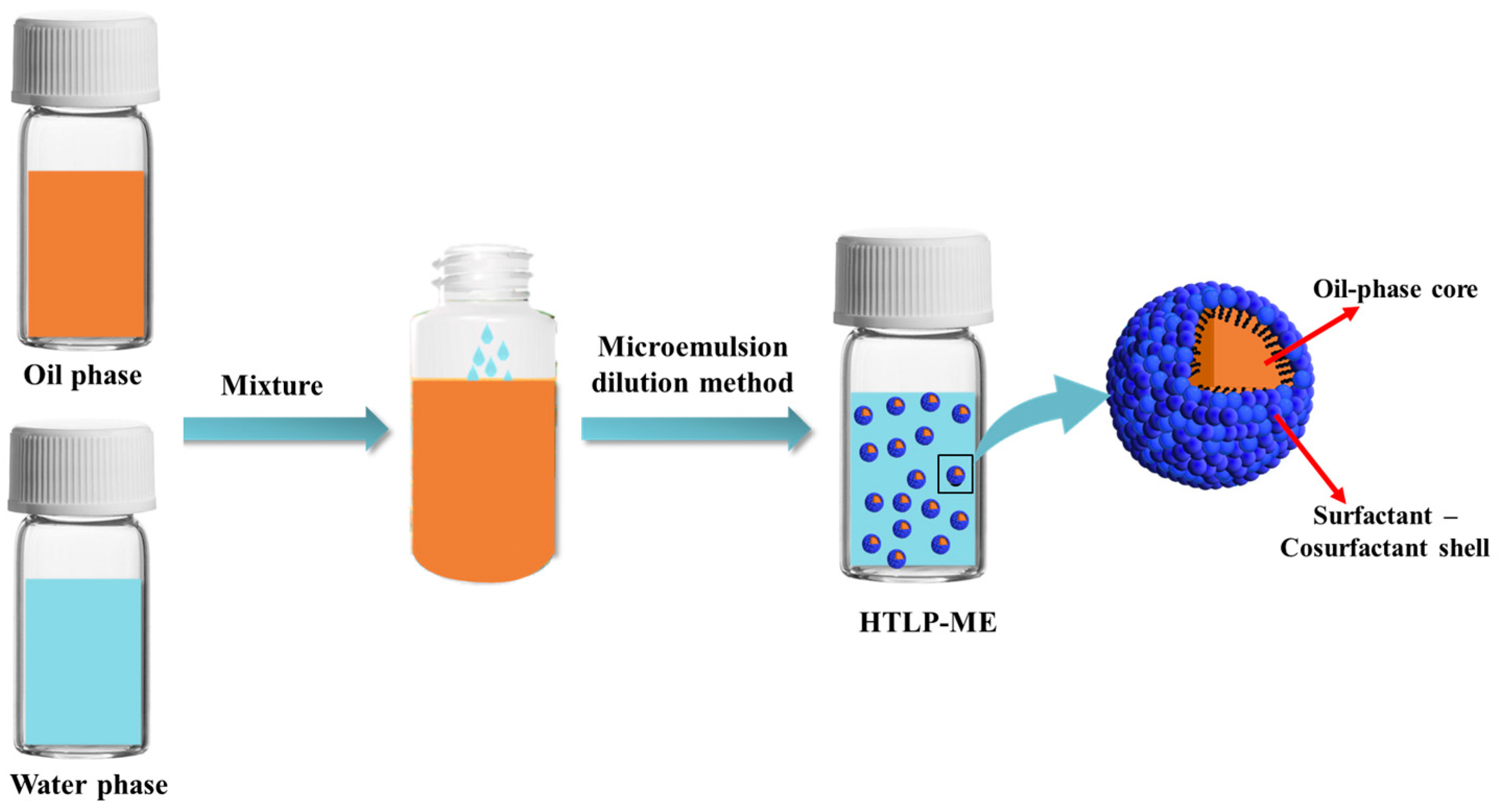
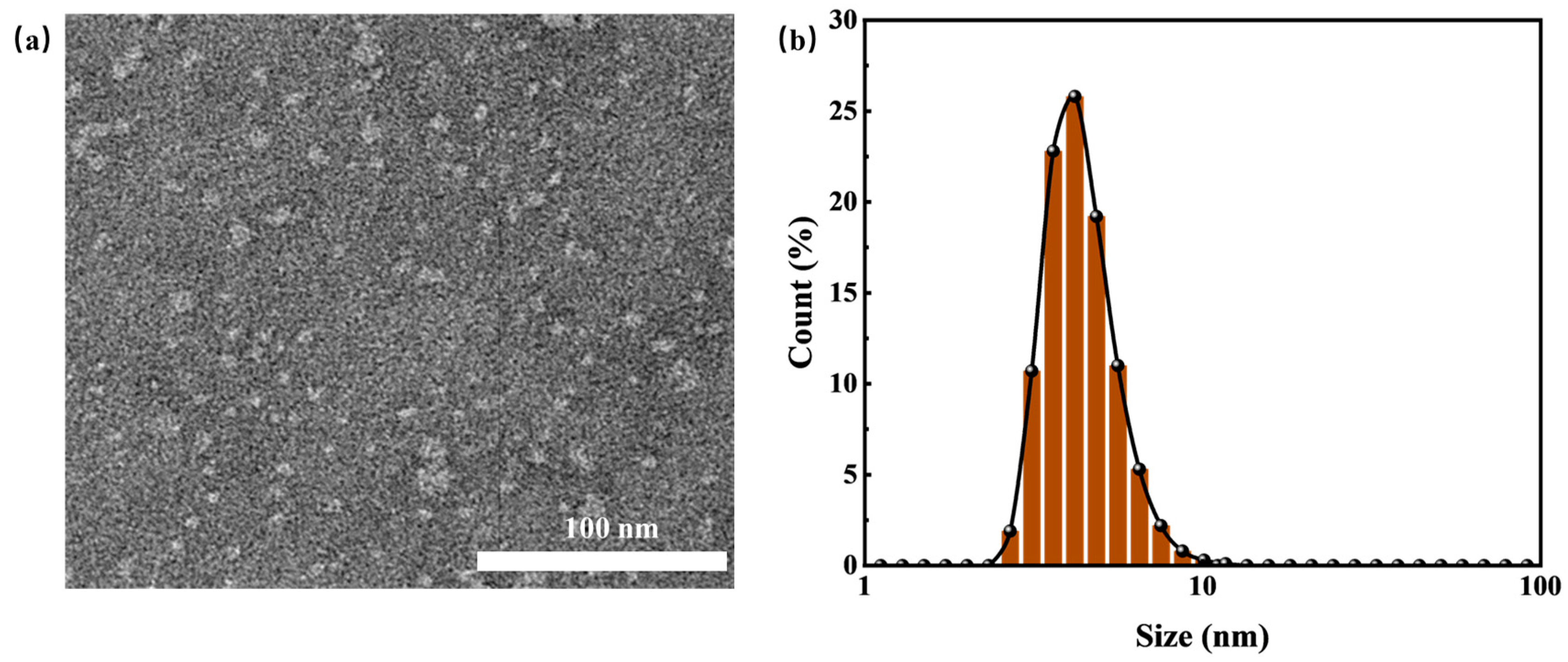
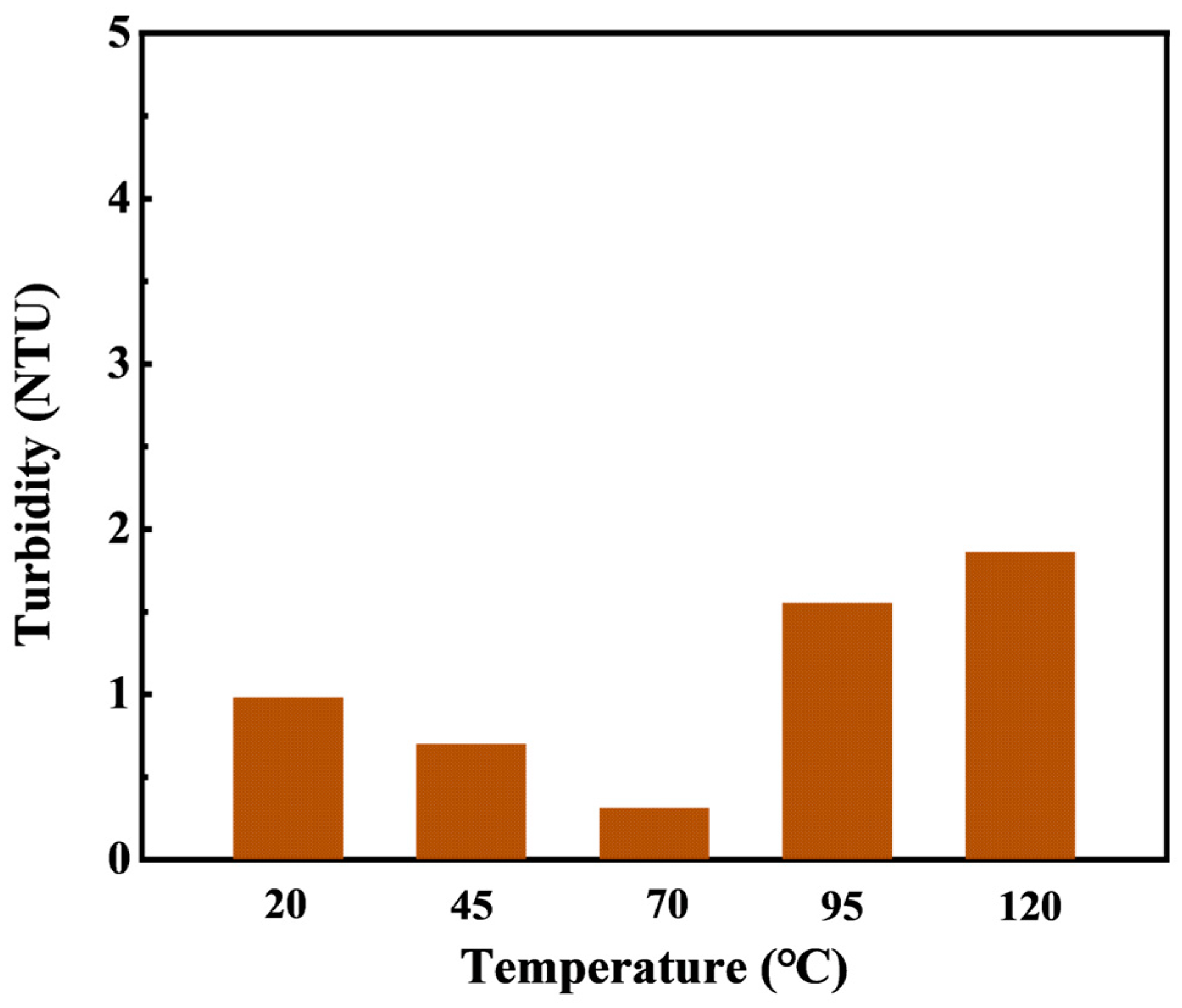



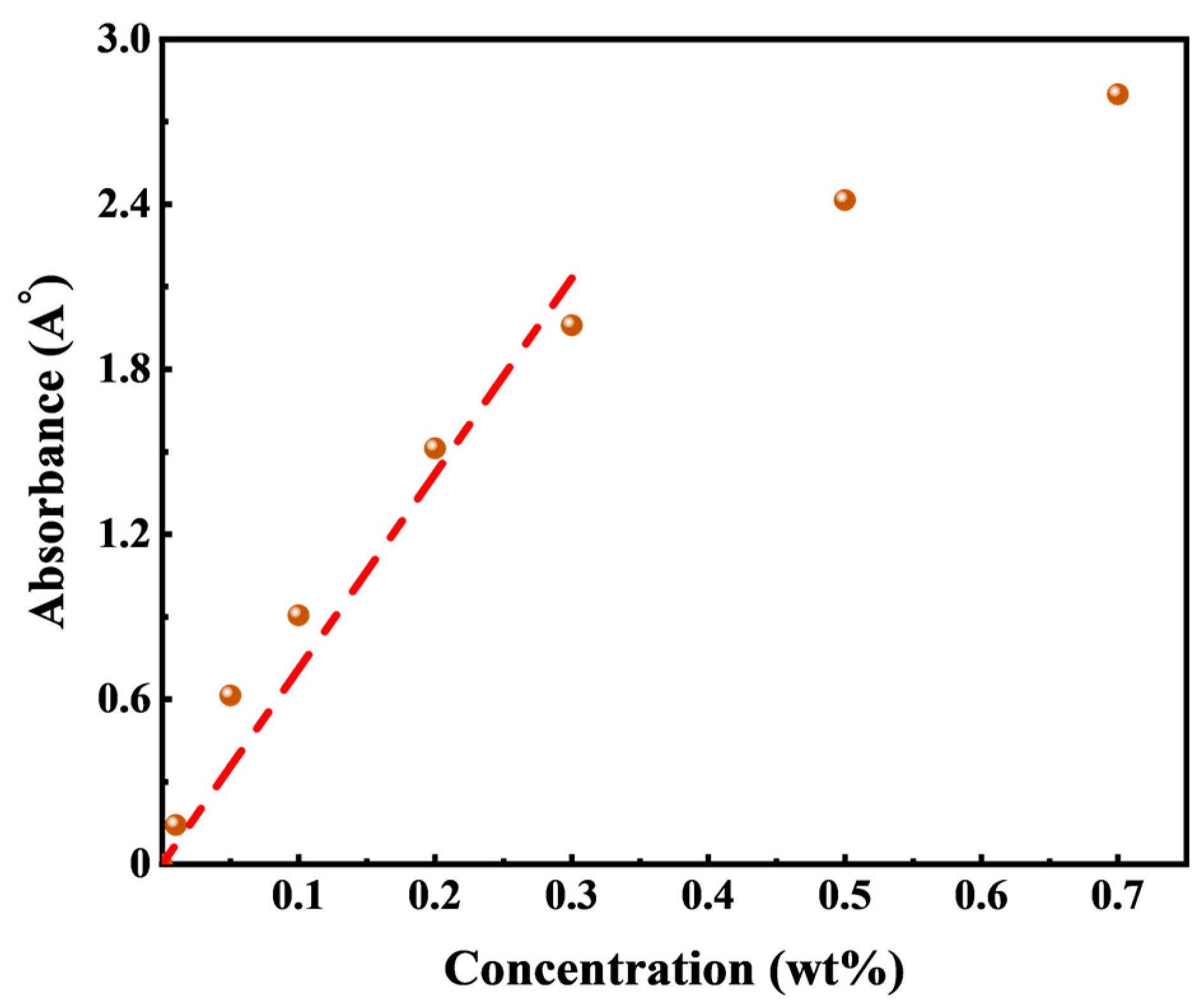
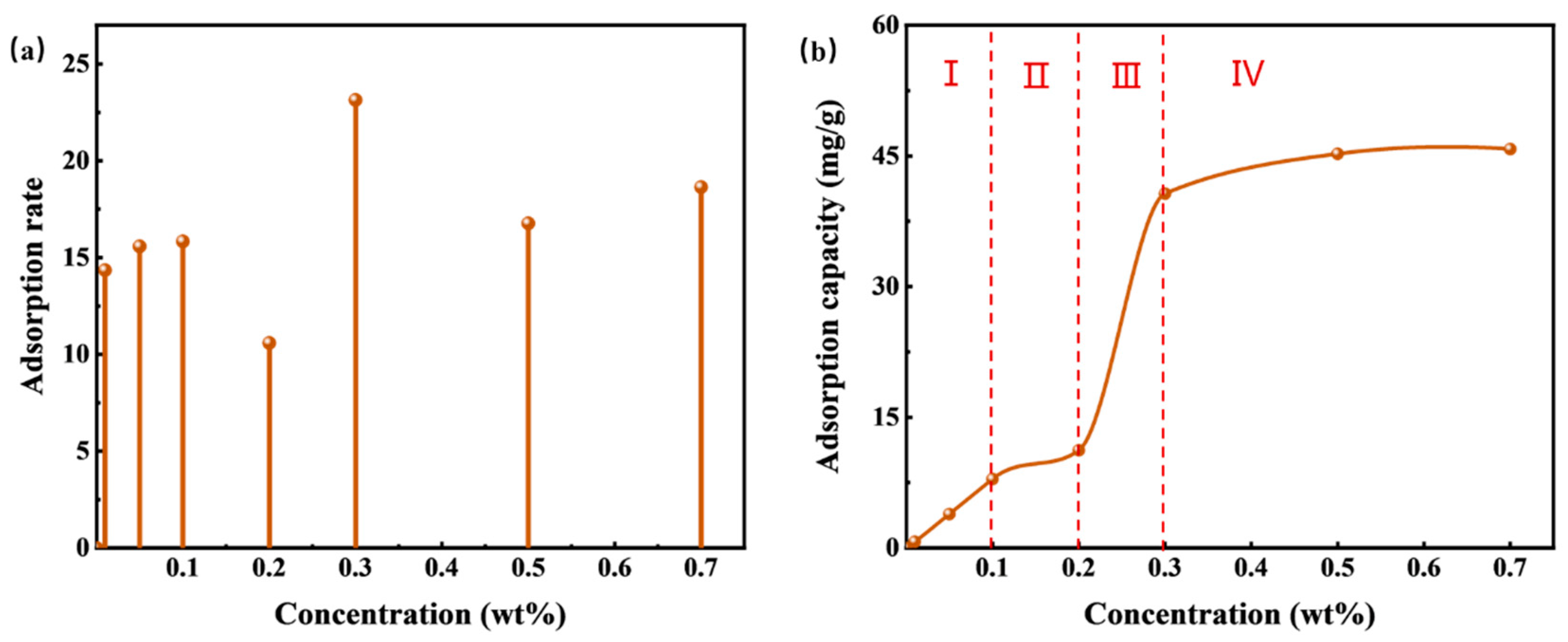
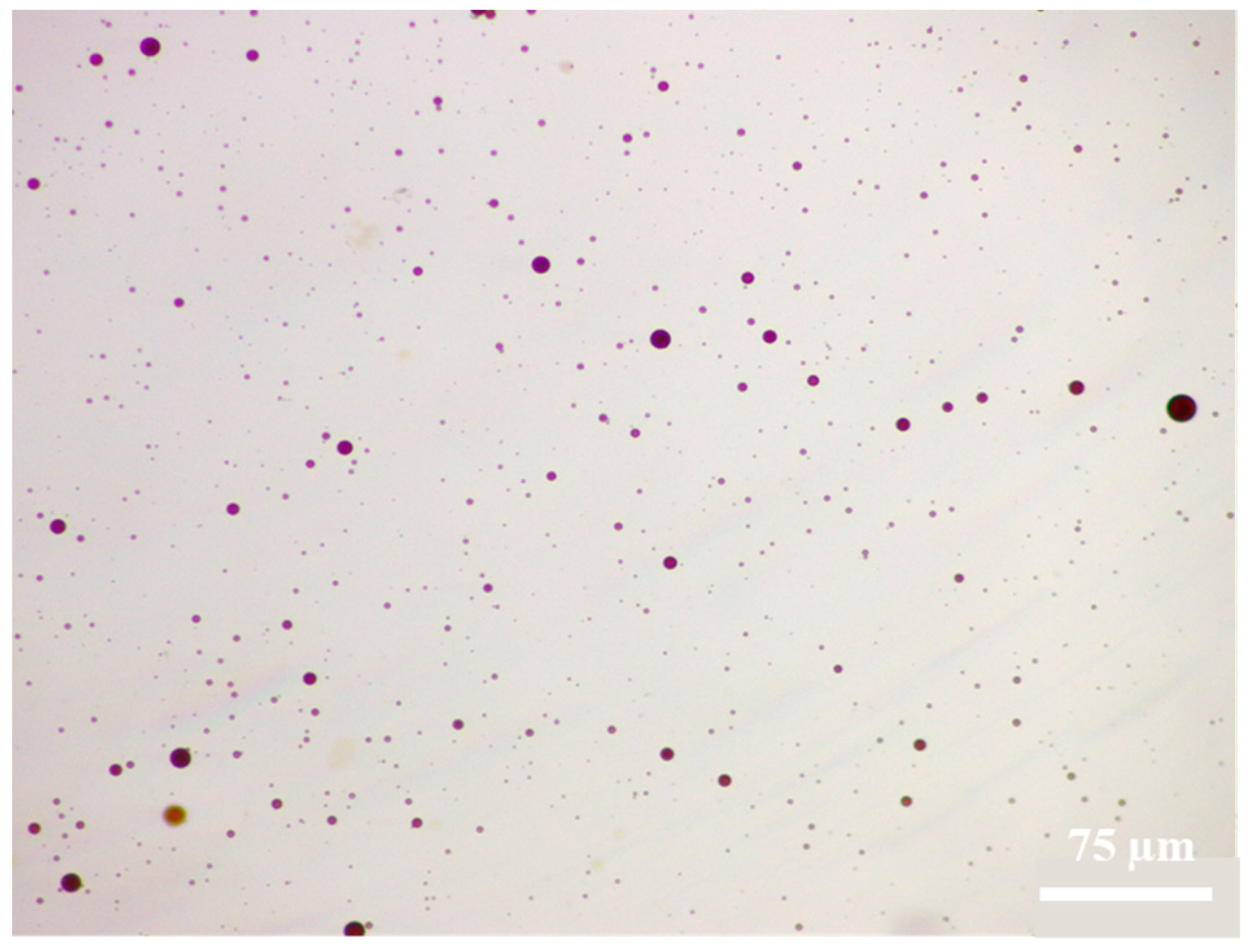


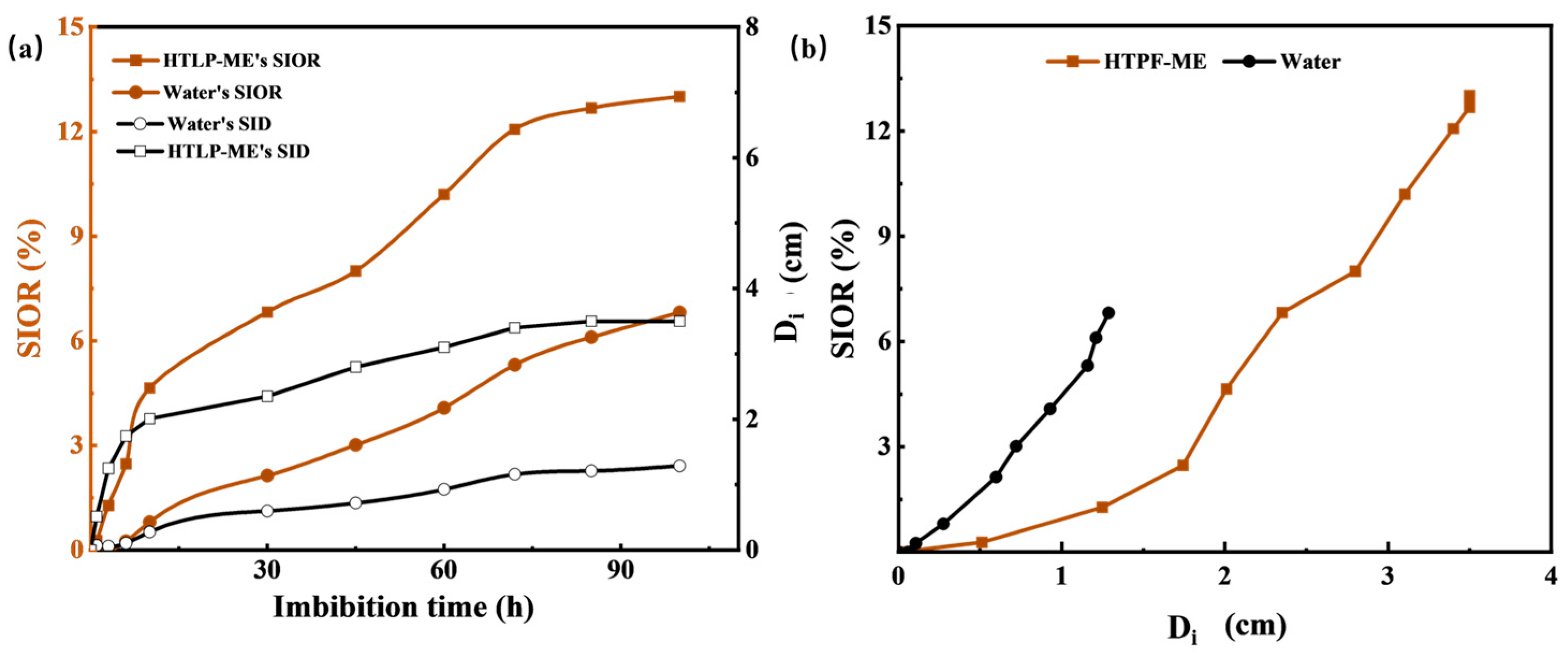
| Number | Length/cm | Diameter/cm | Permeability/×10−3 µm2 | Porosity/% |
|---|---|---|---|---|
| 1 | 5.03 | 2.51 | 0.14 | 9.03 |
| 2 | 5.02 | 2.50 | 0.15 | 9.14 |
| Quality of Each Component (g) | Nonionic Surfactant MOA15 | Cationic Surfactant SS-2306 | Oil Phase No.3 White Oil | Co-Surfactant Triethylene Glycol | Aqueous Phase Fresh Water |
|---|---|---|---|---|---|
| HTLP-ME | 25 | 6 | 20 | 35 | 14 |
Disclaimer/Publisher’s Note: The statements, opinions and data contained in all publications are solely those of the individual author(s) and contributor(s) and not of MDPI and/or the editor(s). MDPI and/or the editor(s) disclaim responsibility for any injury to people or property resulting from any ideas, methods, instructions or products referred to in the content. |
© 2023 by the authors. Licensee MDPI, Basel, Switzerland. This article is an open access article distributed under the terms and conditions of the Creative Commons Attribution (CC BY) license (https://creativecommons.org/licenses/by/4.0/).
Share and Cite
Xiao, L.; Hou, J.; Wang, W.; Raj, I. Development of a Novel High-Temperature Microemulsion for Enhanced Oil Recovery in Tight Oil Reservoirs. Materials 2023, 16, 6613. https://doi.org/10.3390/ma16196613
Xiao L, Hou J, Wang W, Raj I. Development of a Novel High-Temperature Microemulsion for Enhanced Oil Recovery in Tight Oil Reservoirs. Materials. 2023; 16(19):6613. https://doi.org/10.3390/ma16196613
Chicago/Turabian StyleXiao, Lixiao, Jirui Hou, Weiju Wang, and Infant Raj. 2023. "Development of a Novel High-Temperature Microemulsion for Enhanced Oil Recovery in Tight Oil Reservoirs" Materials 16, no. 19: 6613. https://doi.org/10.3390/ma16196613
APA StyleXiao, L., Hou, J., Wang, W., & Raj, I. (2023). Development of a Novel High-Temperature Microemulsion for Enhanced Oil Recovery in Tight Oil Reservoirs. Materials, 16(19), 6613. https://doi.org/10.3390/ma16196613




